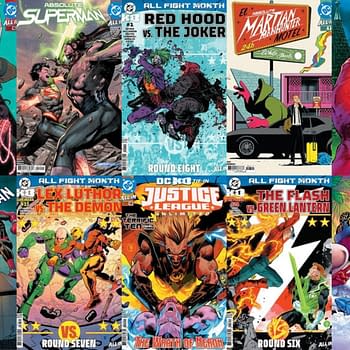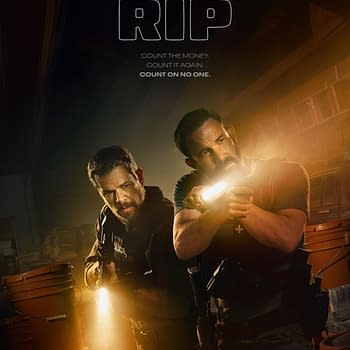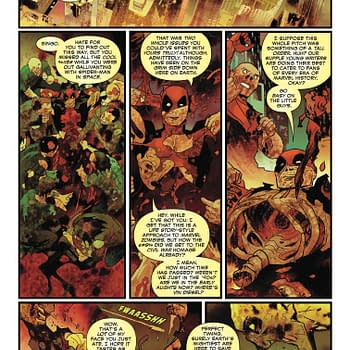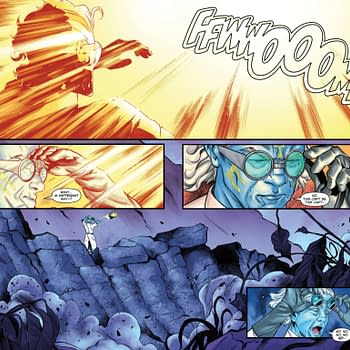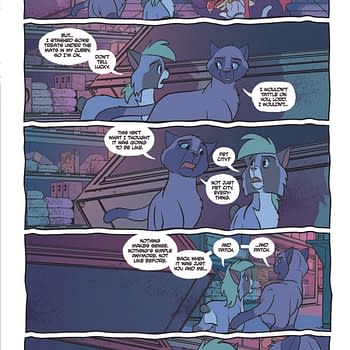Posted in: Comics | Tagged: Comics, dc, entertainment, gendercrunching, marvel
Gendercrunching January 2016 – All-New All-Different Figures
By Tim Hanley
It's another new year of stats fun here at "Gendercrunching", and both DC and Marvel started 2016 with their highest overall percentages of female creators in several months. We also take a look at female characters at the Big Two, and track how their representation has changed over the past six months.
DC COMICS
After a strong second half in 2016, DC's female creator representation ticked up again to begin the year. In January 2016, DC released 71 new comics featuring 614 credited creators, 516 men and 98 women. Let's look at their stats:
DC's overall percentage of female creators rose 1.6%, a decent gain that brought the publisher to their highest total since last summer. By category, almost everything was up, including a sizeable 6% gain for writers and a similar jump for editors. Cover artists, pencillers, inkers, and assistant editors all posted smaller gains. Meanwhile, colorists fell about 4% while letterers slid down roughly 5%. For the most part, DC has started the year heading in a more representative direction.
The Past Year At DC
We're mixing things up a bit this year. Instead of the old "Compared to a Year Ago" section, we've got a new small chart that shows DC's overall percentage of female creators over the past year, so here are DC's numbers from last January to this January:
This month's numbers stack up very well compared to the year before, apart from the monster numbers DC posted during their "Convergence" event in April and May. But for non-event months, January was DC's second best total over the past year, and things seem to be trending in an upward direction currently. DC's female representation has certainly grown considerably since last January.
MARVEL COMICS
Marvel also started the year with an overall gain. In January 2016, Marvel put out 73 new comic books with 604 credited creators, 509 men and 95 women. Here are their numbers:
Their 15.7% for female creators overall was a 0.6% gain from December, not a huge jump by any means but an increase nonetheless. Most of this gain was in editorial, with editors ticking up slightly and assistant editors going up by nearly 6 points. On the creative side of the charts, only writers rose, but it was a sizeable gain of 5%. The drops in the other categories ranged from 1-3%, with letterers remaining at 0% yet again. All together, things shook out on the positive side of things despite there being more categories with losses than gains.
The Past Year at Marvel
And here is Marvel's fancy new chart, showing their overall percentage of female creators from last January to this January:
While Marvel is currently lower than their previous highs from the summer, the publisher's female creator representation is clearly far higher than it was a year ago. The various ups and downs over the year have ultimately added up, and with two months of gains, Marvel is trending upward as well.
FEMALE CHARACTERS AT DC AND MARVEL
It's January, so that means it's time for our semi-annual check in on female characters at the Big Two. Usually our focus is creators, but it's fun to mix things up from time to time and see how the numbers look for the fictional folks these creators write and draw each month.
First up is a look at the characters who appear on the covers of the comics. Covers are how publishers advertise their books and show who will be inside them, and they offer us a good avenue to get a rough count on the characters featured in each book. For methodology, I count up the characters on each cover by gender and tabulate a percentage so each book counts the same, then average out the percentages to get the overall total. There are a couple of side rules: Anthropomorphic animals get counted but real ones don't (so Scooby-Doo, yes; Krypto, no), and I try to simplify homogeneous crowd scenes, so groups of similarly clad villains or onlookers get counted as one.
So let's take a look at the numbers for female characters on DC and Marvel's covers in January 2016, and bi-annually going back to January 2014:
This is, at first glance, not a terribly exciting chart, with the numbers for both publishers looking about like they did last time. And yes, there's been no real significant change since last July. But that actually says a lot. For DC, their numbers have been in the same ballpark for the past two years, with barely a percentage point of difference across all four entries. Given that this is a rough count, such changes are fairly negligible. So DC's stayed very consistent with female character representation, keeping them at slightly less than a third of their characters overall.
Marvel hasn't changed much since last July, but these last two entries are a noticeable jump from the first three, and the consistent numbers here in January show that Marvel has stayed committed to this new level of female character representation. Much like DC, it's a bit less than a third, but that's a definite increase from when their numbers hovered around a quarter. Last year's higher showing wasn't just a flash in the pan.
Turning to female led titles, we've got a similar lack of change when we separate all of DC's monthly series into male-led, female-led, or mixed team/ensemble books. Prepare yourself for another somewhat uneventful chart:
There's barely any change whatsoever from where DC was last July, and for female-led titles there's been next to no change over the last year and a half. It's an interesting outcome because while DC's main superhero line has stayed roughly the same, the Vertigo line went through a massive overhaul in the fall, yet the numbers barely shifted. Male-led books still outnumber female led books about 3 to 1.
At Marvel, the All-New All-Different relaunch has shaken things up a lot, and we've finally got a chart where the numbers have changed:
Male-led books rose considerably over the past six months, but so too did female-led books, while mixed books subsequently tumbled down. Marvel almost doubled their percentage of female-led books, and while they still trail fair behind the male-led books, 19.1% is the highest showing for female characters at either publisher over the past year and a half.
With Marvel's relaunch still unfolding and DC's relaunch coming up in June, it will be interesting to see how these numbers have changed in six months time. I expect that things will look a bit different in every count, but there's been a lot of consistency here despite some big changes at both publishers already. As always in comic book categories that start with "female", there remains lots of room to grow, so we'll find out whether DC or Marvel moved in that direction when we look at the July numbers.
To learn more about this statistics project and its methodology click here, and to see the previous stats click here. You can visit Tim at Straitened Circumstances and follow him on Twitter @timhanley01. His first book Wonder Woman Unbound is available now, and his new book Investigating Lois Lane: The Turbulent History of the Daily Planet's Ace Reporter was just released on March 1, 2016.















